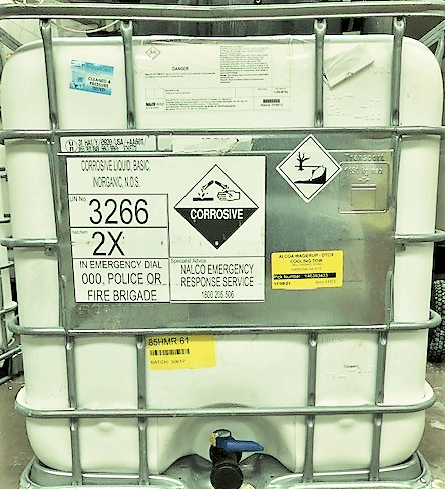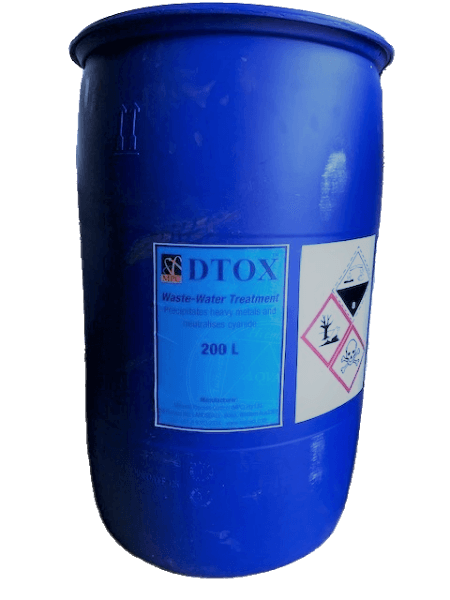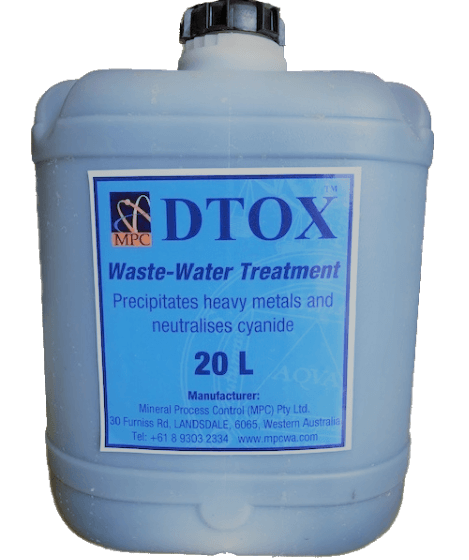
Key Information
- Easy to use
- Readily available
- Manufactured in Western Australia
- More rapid than other methods
- Much safer than hypochlorite
- Comes in solution form
DTOX
DTOX is a waste water treatment product that precipitates heavy metal ions and neutralises cyanide. DTOX reacts quickly with free and complex cyanides. The end products are ultimately released to the environment as carbonates and ammonia (beneficial to flora). Test work has shown that the reaction is rapid and much safer than hypochlorite.
Advantages
Easy to use
Readily available
Manufactured in Western Australia
More rapid than other methods
Much safer than hypochlorite
DTOX comes in solution form
It can be used to rid waste water of such hazardous metals such as chromium, copper, silver, lead, cadmium, mercury, nickel, zinc, arsenic and selenium.
The sulphide component of DTOX precipitates the heavy metals as their very insoluble sulphide minerals (most of which occur in nature). These can then be either recovered for resale or safely discharged into the environment.
DTOX precipitation of metals is relatively insensitive to chelating agents and eliminates the need to treat those wastes separately. This sulfide process has the ability to remove chromates and dichromate without preliminary reduction of the chromium in the trivalent state.
DTOX can be incorporated into previously existing treatment facilities with minimal costs. In most cases a simple dosing pump is all that is required.
Industries that would have an application for the product include gold and silver processing, electroplating and metal finishing where heavy metal ions or cyanide are present in solution.
Procedure for Testwork
Measure cyanide concentration of water to be treated in ppm.
Dose DTOX at a rate of ~2.5mL per tonne of water per ppm of cyanide plus ~7.5mL per ppm heavy metals.
Allow 2 days for reaction and measure residual cyanide and heavy metals
Note: residual cyanide can not be measured by an unmodified silver titration or ion selective electrode due to interference by excess sulphide ion. Use WAD (weak acid dissociable) technique after precipitating and filtration of any excess sulphide with lead acetate).
Applications
Assay Laboratories use DTOX to conveniently and safely neutralise their cyanide and heavy metal waste in their waste water streams.
DTOX may be used on mine sites to destroy cyanide and to precipitate and “lock up” heavy metals in their tailings.
Heavy Metal contaminated ground water plumes have been successfully treated using DTOX. The contaminated water is pumped from the centre of the plume into a treatment facility where DTOX is added to precipitate and collect the heavy metals. The treated water is then returned to the perimeter of the plume effectively forcing the contaminated water into the centre facilitating removal for treatment.
Many electroplaters use DTOX to treat their solution waste prior to disposal.
Indicative costs (AUD ex GST)
(Accurate as of May 2020 but subject to change without notice)
DTOX is sold as a solution containing ~44% w/v active sulphur compounds. It is available in 20 litre drums, 200 litre drums and in bulk.
Full Container Load in 200 litre drums – $POA.
Pallet (4 x 200L drums, 1,000kg) – $1360
200 L drum – $375.00
20 L drum – $58.40
Dose
250 kg DTOX destroys ~ 80kg of cyanide
1 tonne DTOX destroys ~ 320kgs of cyanide at a cost of approx.$3.00 per kg
At 50ppm cyanide in discharge: 20,000 litres of water contains 1kg of cyanide.
Therefore final costs are approximately 18 cents per tonne of water
Background
The reaction between cyanide and polysulfide-sulfur to form thiocyanate was used as early as 1896 to convert hydrogen cyanide in coke oven gas to thiocyanate.
International Environmental Consultants (1979, 1981) investigated the use of the reaction for treatment of cyanide containing wastewaters from the global milling industry. However, no published data were available before the preliminary study by Takaoka and Ganczarczyk (1985).
These experiments were conducted to investigate the reaction in a 2% (20,000 mg/L) solution of sodium cyanide.
It was found that the reaction was 95% complete within one hour, and cyanide concentrations were non-detectable within two weeks at a CN: poly S0 ratio of 1:2 (w/w).
In follow up research, Ganczarczyk et al (1985) studied the reaction in two different cyanide containing waste-water streams.
Initial cyanide concentrations ranged from 11,400 mg/L to 56,000 mg/L. In each case, rapid degradation if cyanide occurred; achieving effective removal of cyanide within three days for the copper/cadmium-plating wastewater, and 99.9% cyanide removal within two days for the copper/nickel plating waste water



